جمهورية شمال القوقاز الجبلية
42°49′N 47°07′E / 42.817°N 47.117°E
Mountainous Republic of the Northern Caucasus | |||||||||
|---|---|---|---|---|---|---|---|---|---|
| 1917–1922 | |||||||||
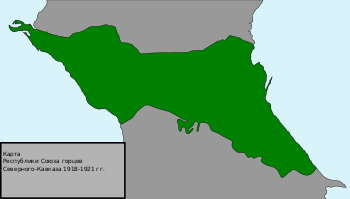 | |||||||||
| العاصمة | Temir-Khan-Shura (now Buynaksk) | ||||||||
| اللغات المشتركة | Abkhaz • Chechen • Ingush • Kabardian (East Circassian) • Karachai-Balkar • Kumyk • Nogai • Ossetic • Russian • other North Caucasian languages | ||||||||
| الدين | Islam (Majority and state-backed faith) Russian Orthodox Church (Minority) | ||||||||
| صفة المواطن | North Caucasian | ||||||||
| الحكومة | Republic under a provisional government | ||||||||
| Prime Minister | |||||||||
• 11 May 1918 – December 1918 | Tapa Tchermoeff | ||||||||
• December 1918 – 12 May 1919 | Pshemakho Kotsev | ||||||||
| التشريع | Parliament | ||||||||
| الحقبة التاريخية | World War I • Interwar period | ||||||||
• Independence declared | 6 March 1917 | ||||||||
• Replaced by Mountain Autonomous Soviet Socialist Republic | 30 November 1922 | ||||||||
| المساحة | |||||||||
• الإجمالية | 430,874 km2 (166,361 sq mi) | ||||||||
| التعداد | |||||||||
• إحصاء 1919 | 11 221 860[1] | ||||||||
| العملة | Tumen | ||||||||
| |||||||||
The Mountainous Republic of the Northern Caucasus (MRNC; also known as the United Republics of the North Caucasus, Mountain Republic or the Republic of the Mountaineers) was an unrecognized state created during the Russian Civil War that existed from 1917 to 1922. It was formed at the congress of the North Caucasian peoples on 6 March 1917 through the unification of Circassians, Chechens, Ingush, Ossetians and Dagestanis.
MRNC included most of the territory of the former Terek Oblast and Dagestan Oblast of the Russian Empire, which now form the republics of Chechnya, Ingushetia, North Ossetia–Alania, Kabardino-Balkaria, Dagestan, Abkhazia and part of Stavropol Krai of the Russian Federation. The total land area was about 430,874 square kilometers (166,361 sq mi), with a population of about 11 million. Its capital was initially at Vladikavkaz, then Nazran, and finally Temir-Khan-Shura.
It broke away from the Russian Empire during the February Revolution, shortly before the start of the Russian Civil War. The state was captured by Soviet Russian forces in 1921, who transformed it into the Mountain Autonomous Soviet Socialist Republic.[2]
State formation
The Union included seven "states" allocated on a national basis and united according to a confederative principle in the territories: Dagestan, Ingushetia, Chechnya, Ossetia, Circassia (Including West Circassia but the union only had control over East Circassia), Karachay-Balkaria, the Nogai steppes and also claims in Abkhazia.[3][4][5]
The Cabinet of Ministers of the Mountain Republic included representatives from almost all regions of the North Caucasus.
History
The Union of the Peoples of the Northern Caucasus was created in March 1917, and an Executive Committee of the Union was elected. The Chairman of the Executive Committee was one of the leaders of the National‐Liberation movement of the Peoples of the Northern Caucasus, Tapa Tchermoeff. The 1847 constitution of Imam Shamil was re-adopted on 5 August 1917 by the Central Committee of the Northern Caucasus.
The independent republic was officially proclaimed on 11 May 1918, after the collapse of the Russian Tsarist empire in the Russian revolution of 1917. The government of the new republic was established. Prime Minister Tapa Tchermoeff, Rashid-khan Kaplanov and Haidar Bammate.[6] The Republic's capital was Vladikavkaz, later moved to Temir-Khan-Shura after occupation by the Red Army.[6][7] The republic was supported by Said Shamil (grandson of Imam Shamil). The Mountainous Republic was de jure recognized by the Ottoman Empire, Germany, the Azerbaijan Democratic Republic, Armenia, the Democratic Republic of Georgia, Ukraine, Bulgaria, Belarus, Latvia, Estonia, France, Finland, the United Kingdom of Great Britain and Ireland, the United States, Italy, Austria-Hungary, Poland, the Don Republic, Japan, and the Kuban People's Republic. The United Kingdom would later ally with Denikin and attempt to re-establish Tsarist rule in the region.[7]
During the Brest-Litovsk negotiations, there was an attempt to send delegates representing the Republic under the supervision of the Ottoman Government, although the Ottomans later rejected this association after a negative reception from the Bolsheviks. On 30 May 1918, the Bolshevik government sent a diplomatic note stating that it didn't recognise the MRNC.[7]
Early in March 1919, General Tapa Tchermoeff and Ibrahim Bey Gaydarov headed a delegation to Paris in an attempt to take part in the Treaty of Versailles. The object of the delegation was to secure the recognition of the independence of the Mountainous Republic of the Northern Caucasus.[8]
The 1st and 2nd Dagestan cavalry regiments from the Caucasian Native Cavalry Division declared loyalty to the Mountainous Republic and Ottoman Pashas of Circassian origin came with their armies to support the new founded state. Therefore, an army with experienced soldiers and commanders was established. North Caucasian soldiers engaged in fierce clashes against the invading White troops of General Anton Denikin's Volunteer Army. The Caucasus was completely taken from Soviet Russia with the support of the North Caucasus Army under the command of Yusuf Izzet Pasha.[8]
In connection with the defeat of Germany and Turkey in the First World War and the withdrawal of Turkish troops from Transcaucasia and Dagestan, the Mountain government was reorganized, and at the end of 1918 the Mountain Congress in Temir-Khan-Shura approved Pshemaho Kotsev as the head of the coalition cabinet. The fighting ended in January 1920, when Denikin's army was completely defeated by the 11th Red Army. In January 1921, the MRNC was completely occupied by the Red Army of Bolshevik Russia and the government of the republic was forced to leave the Caucasus. In January 1921, the Soviet Mountain Republic of the Russian SFSR was established.
Prominent government figures, 1917–1919
Leaders of the MRNC, with Prime Minister Tapa Tchermoeff seated in the front row centre
Abdulmajid Tapa Tchermoeff, oil industrialist, first Central Committee chairman and first prime minister, Chechen. Died in Switzerland in 1937.
Rashid Khan Kaplanov, second Central Committee chairman, Minister of Internal Affairs, Kumyk. Killed by the Bolshevik government in 1937.
Pshemakho Kotsev, second prime minister, Kabardian Circassian. Died in Istanbul in 1962.
Vassan-Girey Jabagiyev, minister of finance, Ingush. Died in immigration in Istanbul in 1961.
Daniyal Apashev, Member of Parliament and chairman in 1919, Kumyk. Killed by Bolsheviks in 1920.[9]
Ibrahim Bey Gaydarov, Minister of Posts and Telegraph,[10] Lezgian. Died in Ankara in 1949.
Alikhan Kantemir, the official representative in neighbouring countries (Azerbaijan, Georgia), Muslim Ossetian. Died in Munich in 1963.
Tadjuddin Penzulayev, minister of justice, Kumyk. Killed by Bolsheviks in 1937.[13] Co-author of Mikhail Bulgakov's piece "Children of Mulla".[14]
Muhiddin Penzulayev, minister of communications, Kumyk. Died in 1942.[13] Brother of Tadjuddin Penzulayev.
Tugan Alkhasov, member of the government, Kumyk. Death circumstances remain unknown.[15]
See also
 History portal
History portal- Caucasian Imamate (1828–1859)
- North Caucasian Soviet Republic (1918)
- Mountain Autonomous Soviet Socialist Republic (1921–1924)
- Confederation of Mountain Peoples of the Caucasus (1989–2000)
- Prometheism
Notes
- ^ L'Europe orientale (Paris. 1919), N2
- ^ World, Abkhaz. "Abkhazia, Georgia and the Caucasus Confederation, by Stanislav Lakoba". Abkhaz World | History, Culture & Politics of Abkhazia (in الإنجليزية البريطانية). Retrieved 2020-03-08.
- ^ «После Февральской революции 1917 г. процесс политического самоопределения привел к образованию Карачаево-Балкарского штата в составе горской республики.» (ИЭА Российской академии наук. Серия энциклопедий «Народы и культуры», «Карачаевцы. Балкарцы.» — М.: Наука, ИЭА РАН, 2014. — С. 7. — 815 с. ISBN 978-5-02-038043-1.)
- ^ Петр Михайлович Шаститко (2002). Обречённые догмы: большевизм и национальный вопрос. М.: Восточная литература. p. 44. ISBN 9785020183056.
- ^ Камалудин Гаджиев (2013). Кавказский узел в геополитических приоритетах России. Litres. ISBN 9785457145672.
- ^ أ ب М. Вачагаев: Союз горцев Северного Кавказа и Горская республика, 2018
- ^ أ ب ت Gülseven, Aslı (2021-03-30). "Büyük Güçler Yarişi Bağlaminda Başariya Ulaşmamiş Bi̇r Bağimsizlik Hareketi̇: Kuzey Kafkasya Bağimsizlik Mücadelesi̇ (1917-1920)". Nevşehir Hacı Bektaş Veli Üniversitesi SBE Dergisi (in الإنجليزية). 11 (1): 245–259. doi:10.30783/nevsosbilen.873522. ISSN 2149-3871. S2CID 233912811.
- ^ أ ب Berzeg, Sefer E. (Mart 2003). Kuzey Kafkasya Cumhuriyeti 1917-1922, Kafkasya Dağlıları Birliği’nin Kuruluşu (I. Cilt). İstanbul : Birleşik Kafkasya Derneği.
- ^ Журнал «Ахульго, Журнал №6, Он служил своему народу.
- ^ "Гайдаров Ибрагим-бек Исаббекович". www.hrono.ru. Retrieved 2021-02-03.
- ^ "Газават.ру :: Личности2".
- ^ "Ценный документ".
- ^ أ ب "Подвигами предков соткана наша история". Ёлдаш (in الروسية). Retrieved 2021-03-19.
- ^ Михаил Булгаков. Фотолетопись жизни и творчества / Юрий Кривоносов. — М. : Вече, 2017. — 480 с.
- ^ Первые государственные образования на Северном Кавказе, (май 1917 – март 1920 гг.), Какагасанов Г. И., Матиев Т. Х., Болдырев Ю.Ф., Назарова О. В., Вестник Ингушского научно-исследовательского института гуманитарных наук им. Ч.Э. Ахриева, 2019
Bibliography
- "Caucasian Republic Mission to the Peace Conference Appeal for Help", The Morning Post, London, Friday 4 April 1919.
- J. "Obedinennyi Kavkaz" ("Vereinigtes Kaukasien"), 1–3 (30–32), München, 1954. (in روسية)
- Baddeley, J. F., 1908, The Russian Conquest of the Caucasus, Longmans, Green, and Co., London
- Madeleine Henrey, Madeleine Grown Up, J. M. Dent & Sons, London, 1954.
- Kathleen R. Jackson, Marat Fidarov, Essays on the History of the North Caucasus, HHN Media, New York, 2009.
- Marshall, Alex (2010), The Caucasus Under Soviet Rule, New York City: Routledge
- Saparov, Arsène (2015), From Conflict to Autonomy in the Caucasus: The Soviet Union and the making of Abkhazia, South Ossetia and Nagorno Karabakh, New York City: Routledge
- Storozhenko (ed.), Ingushetia and Chechen Republic Map, Northern Caucasian Aerogeodesic Company of Roskartografia, Russia, 1995.
- Levan Z. Urushadze, "About the history of the question of unity of the Caucasian Peoples". J. "Amirani", XIII, Montreal‐Tbilisi, 2005, pp. 72–87.
- «Союз горцев Северного Кавказа и Горская республика. История несостоявшегося государства. 1917-1920», М.М. Вачагаев, 2018
- Pages using gadget WikiMiniAtlas
- CS1 الإنجليزية البريطانية-language sources (en-gb)
- CS1 الروسية-language sources (ru)
- Short description matches Wikidata
- Coordinates on Wikidata
- Pages using infobox country or infobox former country with the flag caption or type parameters
- Articles with hatnote templates targeting a nonexistent page
- Articles with روسية-language sources (ru)
- States and territories established in 1917
- States and territories disestablished in 1922
- Post–Russian Empire states
- History of the North Caucasus
- Chechen-speaking countries and territories
- Former countries of the interwar period
- 1917 establishments in Europe
- 1922 disestablishments in Europe


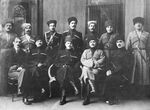
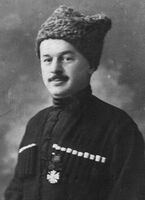
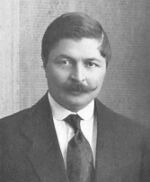

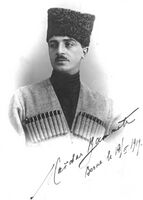

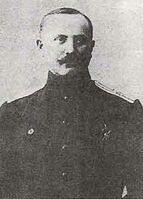
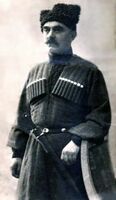
![Daniyal Apashev, Member of Parliament and chairman in 1919, Kumyk. Killed by Bolsheviks in 1920.[9]](/w/images/thumb/a/a4/%D0%90%D0%BF%D0%B0%D1%88%D0%B5%D0%B2%2C_%D0%94%D0%B0%D0%BD%D0%B8%D1%8F%D0%BB.jpg/126px-%D0%90%D0%BF%D0%B0%D1%88%D0%B5%D0%B2%2C_%D0%94%D0%B0%D0%BD%D0%B8%D1%8F%D0%BB.jpg)
![Ibrahim Bey Gaydarov, Minister of Posts and Telegraph,[10] Lezgian. Died in Ankara in 1949.](/w/images/thumb/d/d6/Ibrahim_bey_Haydarov.jpg/150px-Ibrahim_bey_Haydarov.jpg)
![Adil-Gerey Daidbekov, minister of transportation, Kumyk. Died in Baku in 1946.[11][12]](/w/images/thumb/0/04/%D0%94%D0%B0%D0%B8%D0%B4%D0%B1%D0%B5%D0%BA%D0%BE%D0%B2%2C_%D0%90%D0%B4%D0%B8%D0%BB%D1%8C-%D0%93%D0%B8%D1%80%D0%B5%D0%B9_%D0%90%D0%B1%D0%B4%D1%83%D0%BB-%D0%9A%D0%B0%D0%B4%D1%8B%D1%80%D0%BE%D0%B2%D0%B8%D1%87.jpg/150px-%D0%94%D0%B0%D0%B8%D0%B4%D0%B1%D0%B5%D0%BA%D0%BE%D0%B2%2C_%D0%90%D0%B4%D0%B8%D0%BB%D1%8C-%D0%93%D0%B8%D1%80%D0%B5%D0%B9_%D0%90%D0%B1%D0%B4%D1%83%D0%BB-%D0%9A%D0%B0%D0%B4%D1%8B%D1%80%D0%BE%D0%B2%D0%B8%D1%87.jpg)

![Tadjuddin Penzulayev, minister of justice, Kumyk. Killed by Bolsheviks in 1937.[13] Co-author of Mikhail Bulgakov's piece "Children of Mulla".[14]](/w/images/thumb/8/8e/Tadjuddin_Penzulayev.jpg/150px-Tadjuddin_Penzulayev.jpg)
![Muhiddin Penzulayev, minister of communications, Kumyk. Died in 1942.[13] Brother of Tadjuddin Penzulayev.](/w/images/thumb/8/8e/Muhiddin_Penzulayev.png/150px-Muhiddin_Penzulayev.png)
![Tugan Alkhasov, member of the government, Kumyk. Death circumstances remain unknown.[15]](/w/images/thumb/4/4e/Kumyk-Alkhasov-Tugan.jpg/148px-Kumyk-Alkhasov-Tugan.jpg)